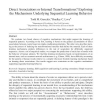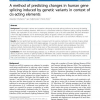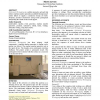79 search results - page 15 / 16 » On Finding Frequent Patterns in Event Sequences |
COGSCI
2010
13 years 8 months ago
2010
We evaluate two broad classes of cognitive mechanisms that might support the learning of sequential patterns. According to the first, learning is based on the gradual accumulation...
BMCBI
2010
13 years 8 months ago
2010
Background: Polymorphic variants and mutations disrupting canonical splicing isoforms are among the leading causes of human hereditary disorders. While there is a substantial evid...
CANDC
2009
ACM
14 years 2 months ago
2009
ACM
Subliminal Wiretapping is a subtly interactive artwork that utilizes random number generation modified through mindmatter effects to supply a continuous stream of words. Frequent,...
JMLR
2002
13 years 7 months ago
2002
The temporal distance between events conveys information essential for numerous sequential tasks such as motor control and rhythm detection. While Hidden Markov Models tend to ign...
SSDBM
2003
IEEE
14 years 1 months ago
2003
IEEE
Life science researchers frequently need to query large protein data sets in a variety of different ways. Protein data sets have a rich structure that includes its primary structu...



